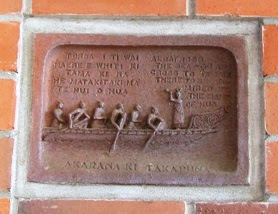Image from Wikipedia.
Another building with NZHPT Category 1 registration. Some history at the link.Built in 1929, it's referred to as an "atmospheric" cinema. In America, these are called picture palaces. Whatever name you apply -- this is a building constructed with the intent of illusion.
Last Friday, I got the opportunity to join a tour led by George Farrant, Auckland City Council Heritage Manager, through three storeys of the interior of the building.
Behind the concrete lacework, George told us there were originally neon lights. They've had to be removed over time, and now the darkness seen through the lace isn't a cavity anymore, but a purple-painted backing.
The verandahs will shortly be in for a refit, due to ponding.
Anyway -- in we went.
Anyway -- in we went.
Fragile elephant tusks.
Discrete disc-shaped sprinklers in the ceilings.
There's 54 horses, so George told us, and he made the original model once the restoration team realised the original horses had completed gone. So now, there's some of George's artwork in the place. He based them on draught horses.
Elephant-and-crocodile lamp.
Another reminder of George Farrant in this picture: the worried man at the edge in blue.
We were apparently quite lucky that this curtain was down during our tour. It isn't commonly seen, except for special screening performances.
One of the two lions. These days, their eyes are blue lights, occasionally twinkling. But I'm sure, when I used to see movies here, they were flashing red. Ah well ...
Each bit of the flamingo curtain, every leaf, had to be sewn individually. It shows much much went into it from the rear.
Behind the curtains ...
... and far, far above the stage.
This is part of the Civic's sky.
The control area for the sky.
Above, a view from the sky down to the stage. George wisely cautioned that we keep a firm hold on the cameras!
A stage light so finely balanced, it can be moved just with fingers.
The restored seating in the auditorioum.




















































































